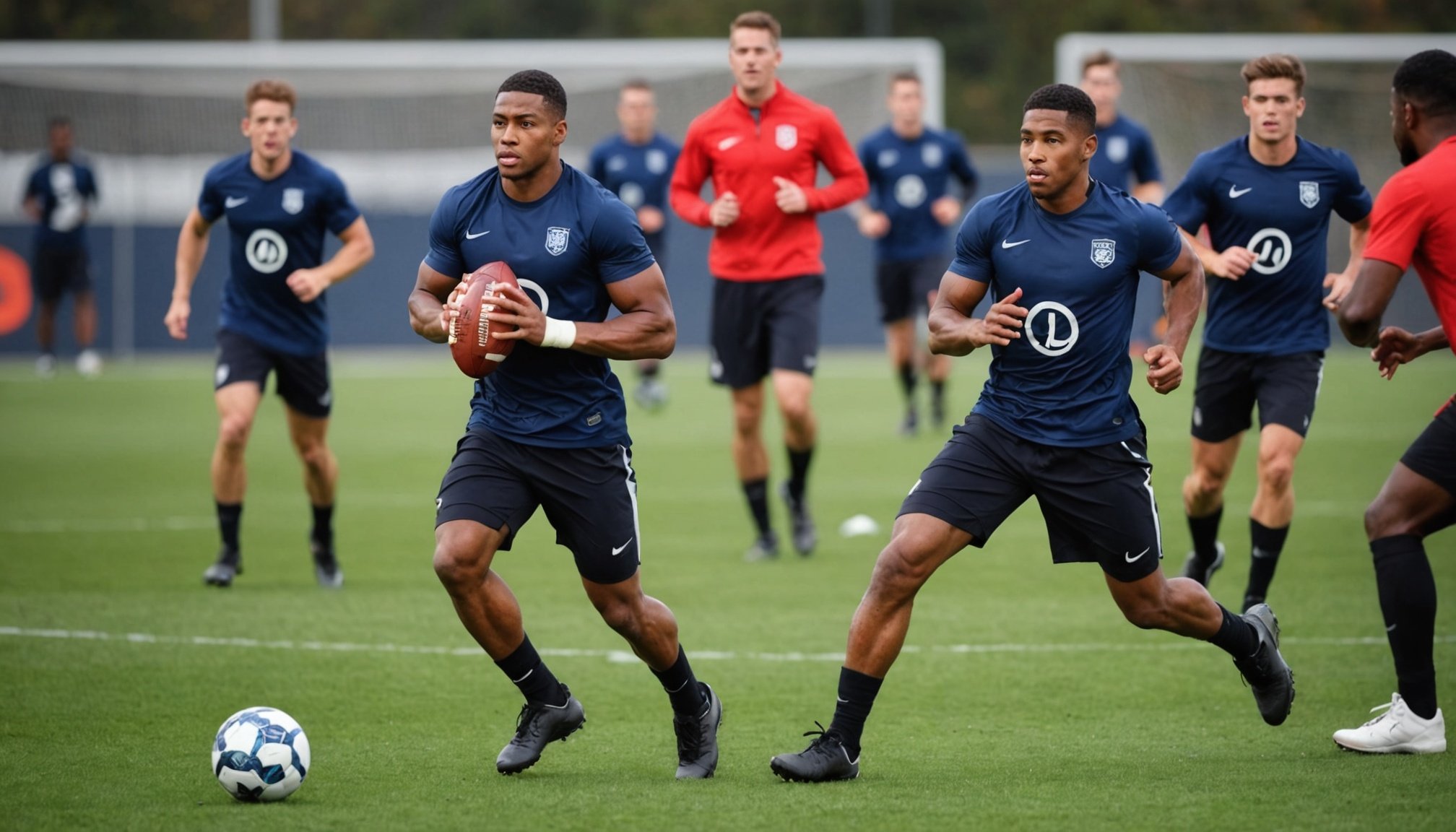Understanding Stamina in Football Players
Stamina in football is crucial as it reflects a player’s ability to sustain prolonged physical and mental effort. It’s a key component that allows athletes to maintain high athletic performance throughout a match. Football players must possess exceptional endurance to perform sprints, tackles, and precise passes, especially in the game’s dying minutes.
Several factors influence an athlete’s stamina. Endurance training is pivotal, as it enhances cardiovascular fitness, allowing players to perform at their peak for longer periods. Factors such as genetics, training intensity, and nutrition also play critical roles in determining stamina levels.
Topic to read : Unlocking Peak Performance: How Football Players Leverage Biofeedback for Enhanced Physiological Responses in Matches
Cardiovascular fitness is at the heart of improving stamina. It involves exercises that increase the heart rate and improve lung capacity, enabling efficient oxygen delivery to muscles. By improving their cardiovascular fitness, players can run longer distances without tiring quickly, which is indispensable in a high-paced sport like football.
Incorporating a comprehensive endurance training program can significantly boost a player’s stamina. Aerobic exercises like running or cycling, coupled with interval training, can be particularly effective. These ensure players are well-equipped to handle the physical demands of football, enhancing their overall performance on the field.
Also to see : Reviving the Game: Strategies for UK Football Coaches to Effectively Support Players Returning from Extended Injuries
What is Periodized Training?
Periodized Training is a strategic approach that involves dividing an athlete’s training program into distinct Training Phases. This method aims to optimise performance by systematically varying intensity, volume, and focus over time. By doing so, athletes can avoid plateaus, reduce the risk of injury, and peak at desired times, such as during competitions.
There are various models of periodized training that cater to different sports and goals. Linear periodization, for instance, is common for beginners, emphasizing gradual progression from low to high intensity. On the other hand, undulating periodization suits more advanced athletes by frequently altering intensity and volume to stimulate continuous adaptation.
Three key principles guide periodized training:
-
Specificity: Tailoring training to meet the specific demands of the sport or athletic event.
-
Progressive Overload: Gradually increasing stress on the body to stimulate physical adaptations.
-
Recovery: Prioritising rest and recovery periods to prevent overtraining and enhance performance.
Understanding these principles helps ensure that athletic programming is both effective and sustainable, underpinning long-term athletic development. By integrating these elements, athletes can achieve optimal results and maintain their competitive edge.
Phases of Periodized Training for Stamina
Periodized training is a systematic approach designed to optimise endurance development. It consists of structured stamina phases aimed at enhancing athletic performance through progressive adaptation. Below, we explore the key phases in this approach.
Preparatory Phase
The preparatory phase is crucial for establishing a robust aerobic base. This phase involves lower-intensity, high-volume exercises, enabling athletes to lay the groundwork for more intense training phases. Incorporating foundational strength exercises during this period is essential for building resilience and reducing injury risks. Recommended duration for this phase is typically two to four months, with an emphasis on gradual intensity increase.
Competitive Phase
In this phase, the focus shifts to sport-specific endurance training, crucial for peak performance. Techniques such as tapering are implemented to enhance athletes’ capacity and readiness for competitions. Skill integration plays a significant role, ensuring that endurance gains translate effectively into performance. Tapering involves reducing training volume while maintaining intensity to allow the body to recover and reach optimal performance levels.
Transition Phase
Finally, the transition phase prioritises recovery strategies and active rest. This phase might incorporate high-intensity interval training (HIIT) to maintain fitness while preventing burnout. Planning for annual training cycles during this time helps in sustaining long-term athletic progress. Effective use of HIIT during recovery can preserve stamina while allowing strategic rest.
Exercises to Boost Stamina in Football Players
Improving stamina in football players requires a balance of aerobic and anaerobic exercises. Aerobic exercises are designed to increase cardiovascular endurance and include activities sustained over long periods, such as running or cycling. On the other hand, anaerobic exercises involve short bursts of intense activity, such as sprints, which focus on strength and power.
Effective endurance exercises are crucial in football training. A prime example is interval training, where players alternate between high-intensity sprints and lower-intensity jogging. This method not only enhances stamina but also mimics the dynamic pace of a football match. Hill sprints, another key component, build leg strength and improve explosive power—a vital skill for quick directional changes during a game.
Incorporating training drills like shuttle runs can also substantially boost a player’s stamina. These drills simulate real-time game conditions, pushing players to perform at peak efficiency.
Football conditioning isn’t complete without cross-training, a model that introduces a variety of exercises to ensure overall fitness. Cross-training helps prevent injuries by diversifying movement patterns and maintaining muscle balance. By integrating exercises like swimming or cycling, players can enhance their stamina while reducing injury risk, thus optimizing their performance on the field.
Real-World Applications and Success Stories
In examining the practical application of periodized training, numerous case studies highlight its efficacy. Top-tier teams and athletes from a variety of sports have implemented this method to enhance their competitive edge. For example, several football teams have reported notable improvements in performance metrics — including strength and endurance — after integrating periodized training into their regime.
Let’s look at a few athletes who have benefitted. According to athlete testimonials, many express increased stamina and precise skill execution, attributing their progress to this systematic approach. One prominent swimmer shared how periodized training allowed for optimal peak performance during championship events.
Coaches also offer valuable insights into the program’s success. A celebrated coach mentioned, “Periodized training adapts to the unique physiological demands of each sport, optimizing athletes’ capabilities.” These affirmations underline the strategic advantage brought by this training method.
Through these examples, it becomes evident that periodized training is not just a theoretical framework. It’s a proven methodology, validated by real-world results, which supports athletes in achieving their highest potential. By prioritizing systematic planning, athletes and coaches alike can witness substantial progress in athletic development.
Practical Tips for Implementing Periodized Training
Implementing periodized training effectively requires strategic planning and ongoing assessment. Start by creating a dynamic training schedule that balances various training tips. Focus on defining distinct phases: preparation, peak, and recovery. Each phase should target different aspects of athletic performance, such as strength, endurance, and flexibility.
Regularly monitor athletes’ progress to ensure that they are on track to meet their goals. Use a combination of coaching strategies like feedback sessions, performance metrics, and even digital tracking tools to assess improvements. Adjust the training program as needed. A flexible approach helps address any stagnation or overtraining issues by tweaking intensity and focus.
Engagement is crucial for stamina improvement and sustained motivation. Encourage your athletes to take ownership of their training journey. Foster open communication to integrate their feedback into the training process. Educate athletes on the why and how behind their routines. This promotes a sense of purpose and commitment.
Include gamified elements or team challenges to make the training journey enjoyable. Instilling a sense of camaraderie and light competition can significantly boost both effort and results.






